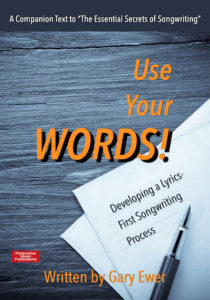Here’s something interesting: the melody that Paul McCartney uses as his verse melody for “You Never Give Me Your Money” (“Abbey Road” album) serves, for all intents and purposes, as a bridge melody for “Carry That Weight.”
True, the fact is that its appearance as a bridge melody is overshadowed by the fact that its main job is as a reprise of an earlier melody in the famous side-2 medley, but the verse-to-bridge repurposing is still applicable here.
 Trying to get a handle on writing song lyrics? Discover the benefits of making a lyrics-first method your new go-to process with”Use Your Words! Developing a Lyrics-First Songwriting Process. It’s FREE right now when you purchase the 10-eBook Bundle.
Trying to get a handle on writing song lyrics? Discover the benefits of making a lyrics-first method your new go-to process with”Use Your Words! Developing a Lyrics-First Songwriting Process. It’s FREE right now when you purchase the 10-eBook Bundle.
It’s hard to come up with other songs or medleys where the verse melody gets reinterpreted later on as a bridge. If you’re at all musically curious, you’ll wonder how that works.
In fact, it’s just a matter of contrast playing its very familiar role in the best pop songs. The reason that the verse-chorus-bridge format works so well in the first place is that they all contrast each other in some way.
Between those three sections, the verse and bridge sections are the ones that relate most closely. That’s because it’s common for a minor verse to transition to a major chorus. And then for contrast’s sake, the bridge moves back to minor before the repeat of the chorus.
Therefore, it’s fairly easy for a verse melody to work as a bridge melody, even if it’s quite rare. And it will work better in a medley situation, or else we’d never hear it as a bridge… It would sound like a repetition of the verse, being in such close proximity.
Contrast is such an important song quality. It keeps us listening. Every section of a song should demonstrate some kind of contrast. In addition to the contrasting of major and minor, you’ll want to consider other ways to have one section of your song differ from others:
- Low melodies and high melodies.
- Loud instrumentation and quiet instrumentation.
- Backing vocals and solo vocal lines.
- Emotional lyrics and narrative lyrics.
- Quick, busy, rhythmically intricate melodies and melodies with simple beat-based rhythms.
And there is a host of other ways that song sections can and should differ from each other.
A song without contrast makes us lose interest fairly quickly. In most pop songs, the chorus should be happening before the 1-minute mark. Assuming that’s true (and for most medium-tempo songs, it is), that means that you should be incorporating some kind of obvious contrasting of musical elements within your song before the 1-minute mark.
It also means that if you find yourself feeling bored with your own song before it gets one minute in, a lack of contrast is probably the reason.
 Written by Gary Ewer. Follow Gary on Twitter.
Written by Gary Ewer. Follow Gary on Twitter.
 “The Essential Secrets of Songwriting” 10-eBook bundle includes several chord progression eBooks, including “Chord Progression Formulas”. Learn how to create chord progressions within seconds using these formulas.
“The Essential Secrets of Songwriting” 10-eBook bundle includes several chord progression eBooks, including “Chord Progression Formulas”. Learn how to create chord progressions within seconds using these formulas.











Pingback: The Daily Muse – April 23rd, 2020 | All About Songwriting
Interesting point that I never thought of before. This inspires me to want to write a medley and try it out. I already have numerous songs that never made it on their own, so I’m thinking of taking the good part of two or three and making a ;medley out of them.
I wonder why I never considered it before?
Great idea!
-G